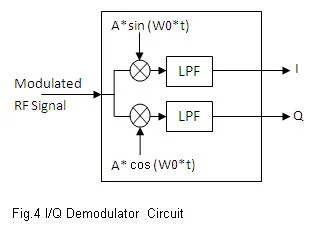Heterodyne receiver vs Homodyne receiver-difference between Heterodyne receiver and Homodyne receiver
This page on Heterodyne receiver vs Homodyne receiver describes difference between Heterodyne receiver and Homodyne receiver. There are two main architecture prevails in radio receiver of any system i.e. Heterodyne and Homodyne. Both heterodyne and homodyne converts modulated RF signal to baseband I/Q signal at zero IF frequency.
Heterodyne receiver
In Heterodyne receiver, it requires one mixer to bring the modulated RF signal to modulated IF signal, which is applied to I/Q demodulator which brings the modulated low IF to baseband at zero IF.

In super heterodyne receiver, it requires two mixers to bring the modulated RF signal to modulated-IF signal. The first mixer brings RF signal to high IF signal and the later mixer brings high IF signal to low IF signal. This is applied to I/Q demodulator which brings the low IF signal to zero IF baseband signals.

Homodyne receiver
In homodyne receiver, it does not require any mixers at RF stage. The modulated RF signal is directly applied to I/Q demodulator which gives baseband signals out (I and Q) at zero IF.

Figure below depicts typical I/Q demodulator circuit which is used in almost all the modems which converts modulated IF/RF signal to baseband signal at zero frequency. For this appropriate frequency f0 is choosen. Here W0=2*pi*f0. Here f0 is the same as RF frequency of modulated signal.

The principle of homodyne receiver is depicted in the figure-3 and figure-4. The signal is first amplified at a low noise stage known as LNA. After the low noise amplification signal is directly converted to the baseband (i.e. direct current signal). If RF frequency signal and LO frequency signals are equal, this circuit works as phase detector. In other words, if LO is synchronized in phase with incoming carrier frequency signal, then the receiver is called homodyne receiver.
Maximum information from modulated I/Q signal is obtained using quadrature down conversion. This is illustrated in fig-4. As shown modulated signal is first split into two channels. These two signals are multiplied by A*sin(w0*t) and A*cos(w0*t). This results into complex signal (I+j*Q) consisting I and Q parts. This vector signal will have magnitude of sqrt(I2+Q2) and phase of tan-1 (Q/I).
The homodyne receiver is also known as direct conversion receiver. The main problem in this type of receiver is LO leakage. This LO leakage need to be as low as possible in order to make RF Transceiver work efficiently to deliver baseband I/Q signals.
Also refer advantages and disadvantages of Homodyne receiver >> and Heterodye receiver >> types.
RF RELATED LINKS
RF frequency conversion
RF mixer basics
modulation
What is Difference between
FDM vs TDM
RF heterodyne versus homodyne receiver
FIR filter Vs. IIR filter
SCPC Vs. MCPC
FDMA Vs. TDMA Vs. CDMA
Diplexer versus Duplexer
rf isolator Vs. rf circulator
Sensitivity Vs. selectivity
